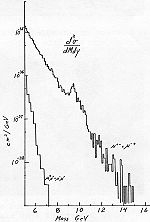Upsilon meson
Appearance
 A plot of the invariant mass of muon pairs, from the Upsilon particle discovery paper. The peak at about 9.5 GeV is due to the contribution of the Upsilon meson. | |
| Composition | b b |
|---|---|
| Statistics | Bosonic |
| Family | Hadrons |
| Symbol | ϒ |
| Antiparticle | Self |
| Discovered | E288 collaboration |
| Mass | 9.46030(26) GeV/c2 |
| Electric charge | 0 e |
| Spin | 1 |
The Upsilon meson (
ϒ
) is a quarkonium state (i.e. flavourless meson) formed from a bottom quark and its antiparticle. It was discovered by the E288 collaboration, headed by Leon Lederman, at Fermilab in 1977, and was the first particle containing a bottom quark to be discovered because it is the lightest that can be produced without additional massive particles. It has a lifetime of 1.21×10−20 s and a mass about 9.46 GeV/c2 in the ground state.
See also
- Oops-Leon, an erroneously-claimed discovery of a similar particle at a lower mass in 1976.
- The
ϕ
particle is the analogous state made from strange quarks. - The
J/ψ
particle is the analogous state made from charm quarks. - List of mesons
References
- Lua error in Module:Citation/CS1/Configuration at line 2083: attempt to index a boolean value.
- Lua error in Module:Citation/CS1/Configuration at line 2083: attempt to index a boolean value.
- Lua error in Module:Citation/CS1/Configuration at line 2083: attempt to index a boolean value.
